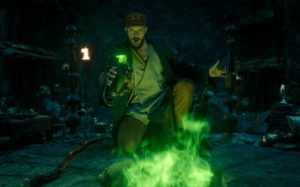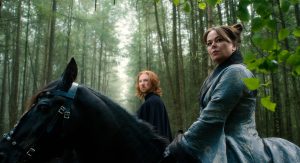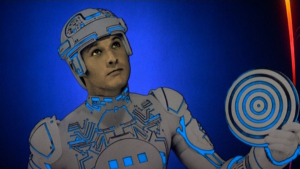We’re all hungry for more news and information about Amazon Prime’s adaptation of The Lord Of The Rings, and so, unsurprisingly, many of us have taken up the habit of theorizing to try and piece together our own news and information. But while many theories have no basis in factual evidence, there’s one that’s been making the rounds recently that actually sounds pretty plausible. I speak of the rumor that actress Kaya Scodelario has possibly joined the cast of The Lord Of The Rings and is moving to New Zealand to begin filming.

The theory came to my attention when it was posted by TheOneRing.net on their Twitter account, but their post did not credit the original theorizer, kayascodsnews, a Kaya Scodelario fan account on Instagram that actually did some very nifty sleuth work and managed to construct a fairly elaborate and convincing theory about Scodelario’s new whereabouts.
As they noted in their theory, Scodelario has been talking on her Instagram about moving away from her home country (the United Kingdom) to an unidentified new location: but she seems to only plan on moving for a year, suggesting that this is for her career, not for any personal reasons. Just a few days ago she embarked on a flight, which she mentioned in her Instagram story would last up to 27 hours – pretty much the exact time it takes to fly between the U.K. and New Zealand. As a going-away present, Scodelario’s friends gifted her a poster for The Hobbit with their faces edited over the thirteen Dwarves and other characters: a funny gesture, or something with a little more significance? If Scodelario has already told that many of her friends that she’s working on The Lord Of The Rings, then she’s not doing a very good job of keeping Amazon Prime’s secrets: but it wouldn’t be at all uncommon for this to happen. Besides, Amazon Prime has been a bit too secretive for my taste recently: since the main cast reveal, we’ve gotten hardly anything from any of their official channels.

That’s the extent of the theory, and since then we’ve had no updates: Scodelario hasn’t yet confirmed where in the world she is now. But with all this in mind, let’s imagine for a minute that Scodelario is, in fact, onboard The Lord Of The Rings series in what I have to assume will be a major role. Who would she be playing? TheOneRing.net pointed out that she bears a striking resemblance to Liv Tyler, who portrayed Arwen Evenstar in Peter Jackson’s The Lord Of The Rings trilogy, and deduced that Scodelario could be playing Arwen’s mother, Celebrían (she can’t be playing Arwen herself, because Arwen isn’t born during the time period when the Amazon Prime series takes place; during the Second Age, over three-thousand years prior to the Quest of the Ring). In the histories of Middle-earth, Celebrían is a bit of a background player until the Third Age, when she gets abducted and brutally tortured by Orcs, leading to her eventually leaving Middle-earth entirely and setting sail for the West. In the Second Age, all we really know about her is that she’s the daughter of the Elven lady Galadriel, and accompanied her during several of her travels. At some point, she met and fell in love with Elrond Half-elven. For an actress like Scodelario (who has had major roles in several franchises, including the most Pirates Of The Caribbean movie) to be attracted to this role, the character’s story would almost certainly have to be expanded through original material – which isn’t a problem, if you ask me, but anything that diverges even slightly from the books is bound to court with controversy. Whoever she’s playing, Scodelario’s recent success as an action star in the horror-thriller Crawl suggests to me that her character would have some sort of action element (and on a side-note, Scodelario’s sister in Crawl was played by Morfydd Clark, who will play Galadriel in The Lord Of The Rings according to all sources: would it be so much of a stretch for Scodelario to now play her daughter?).

But now we’re moving away from the facts. Simply put, we don’t know whether Kaya Scodelario is in The Lord Of The Rings: it’s possible she’s filming something else entirely (the Resident Evil reboot, for instance), or not filming anything at all. It’s possible she’s not even heading to New Zealand. But while this is merely a rumor for right now, it’s a rumor with a grain of truth – which means we shouldn’t discount it just yet, but should instead keep a close eye on Scodelario’s next move.
What say you? Does it seem likely to you that Scodelario has joined the cast, or are you wary to jump to conclusions? Share your own thoughts, theories and opinions in the comments below!









